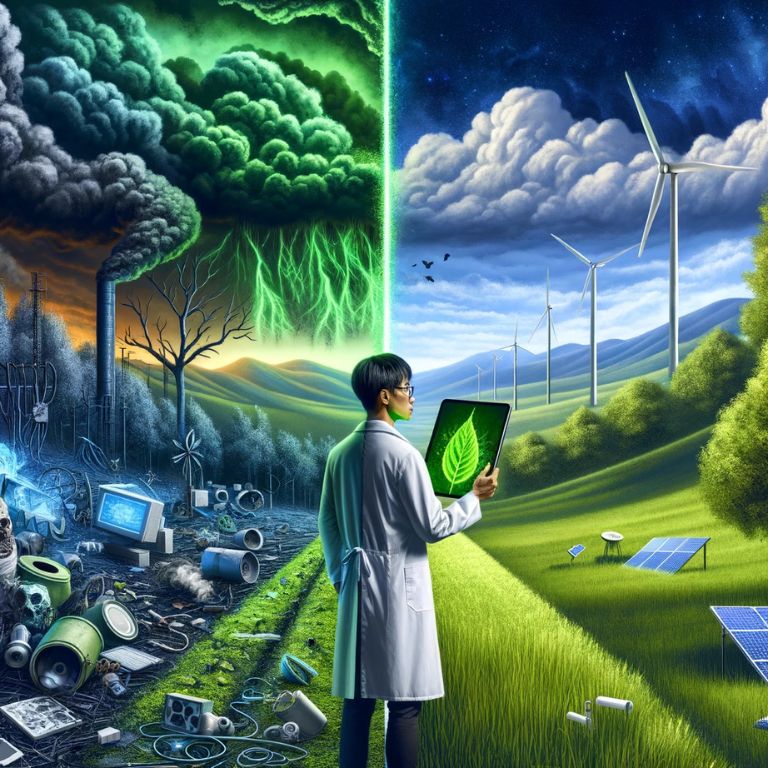For much of its history, the tech industry’s mission has been to create smaller, faster, and more powerful computing devices, with little consideration for their environmental impact. This approach was understandable during the early stages of the digital revolution when the environmental footprint of technology was smaller. However, as technology has become a ubiquitous part of our lives, its environmental impact has grown significantly.
Today’s tech industry faces a crucial challenge: balancing its drive for innovation with environmental responsibility. This shift in focus is being led by initiatives like those at the Harvard John A. Paulson School of Engineering and Applied Sciences (SEAS), advocating for sustainable tech development. This involves integrating environmental considerations into every stage of the computing lifecycle, from design to disposal.
The Silent Environmental Cost of High-Performance Computing
As the computational power of our technology reaches new heights, so does its hidden environmental toll, raising concerns about the sustainability of current computing practices.
Energy Consumption of Data Centers
High-performance and cloud computing have revolutionized technology but at a significant environmental cost. Data centers, the backbone of these operations, consume vast amounts of energy for powering and cooling their systems. This direct energy usage is a primary concern, as it contributes heavily to carbon emissions.
The Indirect Environmental Impact
Beyond direct energy consumption, the manufacture and maintenance of hardware components also have a substantial environmental impact. This indirect effect amplifies the overall environmental footprint of high-performance computing systems.
Rising Demand and Future Projections
The demand for energy in the tech sector is projected to increase dramatically. Estimates by Greenpeace suggest that by 2025, the technology sector could account for 20% of global electricity consumption, up from the current 7%, due mainly to the expansion of cloud computing and development of energy-intensive technologies like artificial intelligence.
Towards Sustainable Solutions
Efforts to mitigate these impacts are underway, focusing on energy-efficient hardware, renewable energy sources for data centers, and optimized software for energy efficiency. These solutions aim to reduce the environmental footprint of high-performance computing, balancing technological advancement with sustainability.
Quantifying the Carbon Footprint of Computing
The environmental impact of computing extends far beyond the walls of data centers. As computing becomes increasingly ubiquitous in our daily lives, its carbon footprint becomes a critical concern. This section explores the environmental effects of computing in terms of carbon emissions, offering insights into how these emissions can be quantified and addressed.
Carbon Emissions from Computing Devices
Computing devices, ranging from personal computers to smartphones, contribute significantly to carbon emissions. This impact begins from the manufacturing process, which involves energy-intensive production of components like semiconductors, and extends to the usage phase, where electricity consumption for operating these devices adds to their carbon footprint. The emissions associated with these stages can be substantial, depending on the energy sources used in production and operation.
The Role of Data Centers
Data centers are major contributors to the carbon footprint of the tech industry. These facilities require vast amounts of electricity for powering servers and cooling systems. Much of this electricity is sourced from fossil fuels, leading to high carbon emissions. The shift toward renewable energy sources in powering data centers is a positive trend, but the overall impact remains significant.
Industry-Reported Environmental Effects
Several tech companies and industry groups have started reporting the environmental effects of their operations, including carbon emissions. This transparency is crucial for understanding and addressing the carbon footprint of computing. These reports often include data on emissions from manufacturing, operation, and end-of-life disposal of computing devices.
Reducing the Carbon Footprint
Efforts to reduce the carbon footprint of computing include designing more energy-efficient devices, utilizing renewable energy sources, and improving recycling and disposal processes. Innovations in hardware and software that reduce energy consumption can have a substantial impact on lowering emissions. Additionally, increasing consumer awareness about the carbon footprint of devices can drive demand for more sustainable products.
The Lifecycle Impact of Desktop Computing
The environmental impact of desktop computing is a multifaceted issue, spanning across various stages of a device’s lifecycle. This section examines these stages—manufacture, use, and disposal—highlighting their individual contributions to environmental degradation and exploring potential strategies for mitigation.
Manufacturing Impact
The manufacturing phase of desktop computers is resource-intensive, involving the extraction and processing of raw materials and the assembly of components like circuit boards, processors, and displays. The energy consumed during this phase largely depends on the methods and sources of energy used in production facilities. Additionally, the extraction of raw materials, often involving mining, has significant ecological and carbon footprints.
Energy Consumption During Use
Once in operation, desktop computers consume electricity throughout their lifecycle. The energy efficiency of these devices varies widely, influenced by factors such as the design of the hardware, the efficiency of the power supply, and the power management features of the operating system. Studies have shown that energy consumption during use can be a significant portion of a desktop computer’s total environmental impact, especially in cases where the device is left running continuously or inefficiently.
End-of-Life Disposal
The disposal phase poses another environmental challenge. Electronic waste (e-waste) from obsolete or broken desktop computers can lead to significant environmental harm if not properly managed. E-waste often contains hazardous materials like lead, mercury, and cadmium, which can leach into soil and water, causing contamination. Proper recycling and disposal of e-waste are crucial to minimize its environmental impact.
Towards a Sustainable Lifecycle
To address these issues, several strategies are being implemented and explored:
- Eco-friendly Manufacturing: Efforts are being made to use more sustainable materials and energy-efficient production processes in the manufacturing of desktop computers.
- Energy-efficient Design: There is an increasing focus on designing computers that consume less power during operation, through better hardware design and power management software.
- Recycling and Reuse: Programs for recycling and reusing components of old computers are becoming more widespread, helping to reduce the demand for new raw materials and minimize e-waste.
Conclusion
The journey through the environmental impact of computing underscores a crucial reality: the tech industry’s innovations have come with a significant environmental cost. From the energy-intensive operations of data centers to the lifecycle impacts of desktop computing, it’s clear that the current trajectory of technological advancement is not environmentally sustainable.
This realization calls for a paradigm shift in the tech industry. Sustainable computing practices, including energy-efficient designs, renewable energy usage, eco-friendly manufacturing, and responsible e-waste management, are no longer optional but essential. These practices represent a balance between innovation and environmental stewardship, ensuring that technological advancements contribute positively to our world without compromising the health of our planet.




